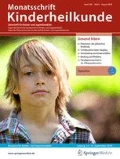Zusammenfassung
Hintergrund. Nach interagierenden Modellen der Entwicklung von frühgeborenen Risikokindern kompensiert ein positives soziales Klima nachteilige Entwicklungslangzeitfolgen. Anhand der Daten aus der bayerischen Entwicklungsstudie bezüglich der kognitiven und Verhaltensentwicklung ehemaliger, sehr unreifer Frühgeborenen wurden die Auswirkungen von medizinischen und sozialen Risikofaktoren untersucht. Die kognitive und schulische Entwicklung waren bei sehr unreifen Frühgeborenen (<32 SSW) eher mit medizinischen als sozialen Faktoren korreliert, bei Kindern mit mittlerem bis niedrigem Risiko war das Gegenteil der Fall. Hochrisikokinder wiesen eine geringere Plastizität des Organismus und eine niedrige Aufholtendenz in frühen Entwicklungsphasen auf.
Schlussfolgerung. Die aus den Erfahrungen an vor 30 oder 40 Jahren geborenen Hochrisikokindern entwickelten Modelle können nicht ohne Weiteres auf Hochrisikokinder des 21. Jahrhunderts übertragen werden. Auswirkungen der gefundenen Abhängigkeiten auf frühe Interventionsstrategien und die klinische Versorgung von früh geborenen Risikokindern werden diskutiert.
Abstract
Background. Interactional models of the development of neonatally at risk infants propose that a good social environment provides protection against longterm adverse developmental outcome. Using data from the Bavarian Longitudinal Study that investigated the cognitive and behavioural development in neonatal at risk children, the interrelationship between medical and social risk factors was re-inspected. Cognitive and school outcome was better predicted by neonatal risk than social factors in the VLBW population (<32 weeks gestation) while the reverse was true for infants born at moderate to low neonatal medical risk. Less plasticity of the organism was found if subjected to a high level of neonatal risk and the infants showed poorer recovery in early growth and cognitive functioning.
Discussion. It is concluded that developmental models of medically high risk infants born some 30 or 40 years ago cannot be uncritically applied to neonatal high risk infants in the 21st century. Implications for early intervention strategies and clinical follow-up of neonatal at risk infants are discussed.
Author information
Authors and Affiliations
Rights and permissions
About this article
Cite this article
Wolke, D., Schulz, J. & Meyer, R. Entwicklungslangzeitfolgen bei ehemaligen, sehr unreifen Frühgeborenen Bayerische Entwicklungsstudie. Monatsschr Kinderheilkd 149 (Suppl 1), S53–S61 (2001). https://doi.org/10.1007/s001120170009
Issue Date:
DOI: https://doi.org/10.1007/s001120170009

